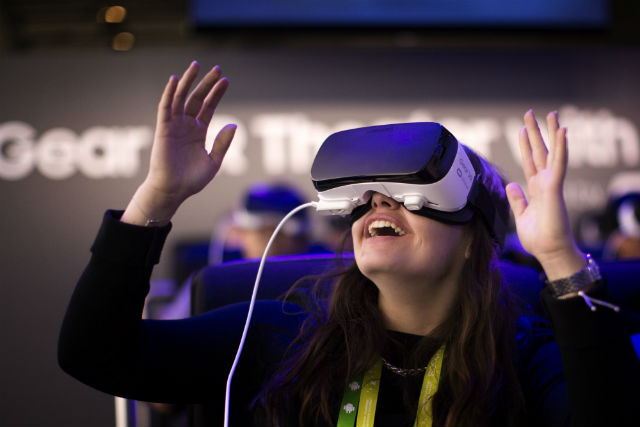
Virtual Reality vs Augmented Reality
Augmented and Virtual Reality are two different things. Reality is termed as the state of being actual or real! And, we pretty much find ourselves satisfied with the reality around! The real people, real objects, real places and everything. But, human mind always wanted something beyond the borders of ‘real’. We had fantasies, fairy tales and myths from the early times. And, now, they have made their ways to something scientific – Augmented and Virtual Reality. If you have been through the technology updates in the past years, you would have heard of both Augmented Reality and Virtual Reality, which are commonly known as AR and VR.
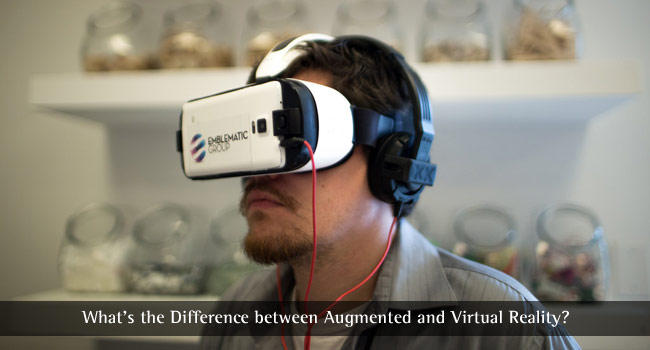
Both these technologies offer something beyond our concepts of reality — often by modifying the real or creating entirely new ones. But, don’t think these technologies are same. There are certain differences that keep AR and VR apart and they are pivotal. In the gist, you cannot use Augmented and Virtual Reality for the same purpose.
In this article, we shall have an overview on the differences between AR vs VR. We try to make this article as informative as possible. So, we will try to break down the pivotal aspects of Augmented Reality and Virtual Reality here.
Before we list out the differences, we will see the common stuff.
Table of Contents
What’s Common Between Augmented and Virtual Reality
Yes, there are certain elements that keep AR and VR in the same bowl. We can list them, for easier understanding.
- Head Mounted Displays: For decades, we have been seeing things on fixed displays – like your monitor, laptop screen, Smartphone screen or any other LCD/LED Display. Head Mounted Displays, commonly known as HMDs, are something different here. They bring the display directly into your eyeballs – by bridging the space in-between. You can wear an HMD by wrapping it around your head or using other means. In case if you did not know, both the AR and VR technologies make use of HMDs. In one way or another. Sometimes, you can use the huge, box-based display wearable. But, sometimes, it’s just about goggles or some specially-made glasses.
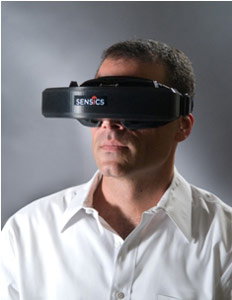
- The Border of Reality: This is something obvious. As the Inception says, dreams are real when you’re in it, right? So, as it happens, both AR and VR – if executed well, take you out of the concept of reality. But, once inside, you feel completely real – which is pretty much all the perks of AR and VR technologies. At this point, both the technologies are same.
Now that you know the basics of both AR and VR, we will go deep into each. We can have definitions, practical versions, purposes and the current scenario of usage. And, we will start with Augmented Reality.
Augmented Reality – Modifying the Reality
Before we go, let’s have an Augmented Reality definition first.
“Augmented Reality is a technology that superimposes a computer-generated image on a user’s view of the real world, thus providing a composite view.”
Now, let’s break this down and make things simpler.
Augmented Reality is about bringing another digital layer on top of the real stuff. This technology makes use of different hardware such as processors, displays and sensors. Using all these, digital information is manipulated and is put over the real layer. So, from the user’s point of view, he/she can have a real-life viewing experience.
You might be sitting on your couch and looking at the wall. In seconds, you can see zombies coming into the place and trying to snatch you. You can use some virtual weapons to attack them back, and that’s how AR works. In most cases, Augmented Reality is extremely interactive. It means that the changes will be as instant as possible. If you attack one zombie, you can see the bruises right away.
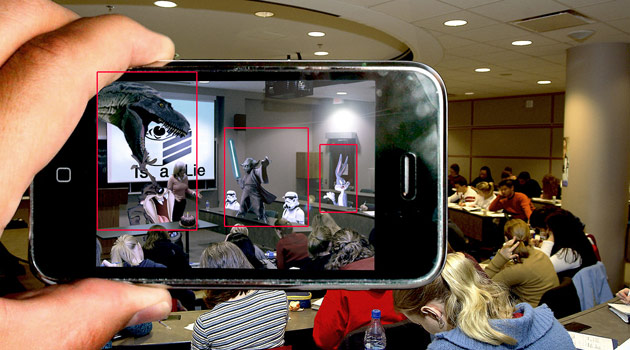
In another instance, you are looking at a printed picture. And, you can see the 3-Dimensional, Interactive model of same objects in front of your eyes. You can squeeze it, expand it, or even change the shape. It all happens virtually, but you see that something real.
These are the basic things about Augmented Reality, apart from the definition. Now, we will take a look at the hardware, products and the intended purposes of AR.
The Hardware and Projects
Though the visual is blended with the real world, Augmented Reality relies upon a Head Mounted Display. This necessarily does not need to be a full-covering display. On the other hand, different products use different stuff like glasses, goggles and specially-made visors.
These HMDs are equipped with certain sensors as well. For instance, there will be one to detect your hand movement. At the same time, another sensor will be recording the direction, speed etc. In short, these HMDs collect enough information to blend the virtual elements into the real world. That is, when you turn around, the virtual imagery should too, right?
We have the basics about the hardware requirements of Augmented Reality. Now, we will see a few projects that take up AR quite ambitiously.
- Google Glass: Google Glass is perhaps the most popular product from the world of Augmented Reality. It’s disappointing that Google is not currently in the development, though under-the-hood movements are there. Just like the name, Google Glass is a pair of spectacles that you can wear. Glass would show the information on the provided screen, blending it with the real world around. One of the best wearable technologies ever envisaged, Google Glass could not make it to success. Following public release in May 2014, Google Glass faced many criticisms and legal issues. Nevertheless, Google Glass is expected to have a perfected version in the near future, though there’s no date estimate.
- Microsoft HoloLens: Microsoft HoloLens is another active product in the world of Augmented Reality! It’s more inclined towards Mixed Reality that is achieved through high-end hardware and life-like rendering of digital information. Often read along with the Windows Holographic platform of Microsoft, HoloLens is now available for pre-order in countries like UK, Australia, France, Ireland, New Zealand and Germany. Microsoft HoloLens has an ergonomic design for better viewing and features. It does not transport you to another world. On the other hand, it’s about enriching the current world with holograms. This is an active project and we can expect the public version soon.
- Magic Leap: Magic Leap is another worth-counting-on project that focuses on Mixed Reality. As said, Mixed Reality takes up different elements from Augmented and Virtual Reality, though the former is pivotal. It’s basically a start-up that works on HMDs that bring digital and real worlds together. The best part is that Magic Leap is funded by giants such as Sundar Pichai and Richard Taylor and the technology is quite promising. It is using light-field chips for data projection but the design prototype is still a secret. That said, judging by the demo videos and all, Magic Leap provides a state-of-the-art AR experience, be it for gaming or day-to-day life.
Notable Applications of Augmented Reality
So, here comes the list of intended purposes of AR. We’ll make it quite brief.
- Better Navigation: You can receive directions as you walk, in front of your eyes. You get notifications and signs as you walk.
- Gaming: With Augmented Reality, Gaming is real, like never before. You can convert any space into a gaming environment (say, your backyard) and play with your friends or strangers. It all blends to the digital renderings and real elements. You should try your hands on one of the Augmented Reality Games, they are worth to give a shot.
- Education is the one to benefit most from Augmented Reality. Let that be complex diagrams or models, everything can be seen in front of your eye. You can interact with the models and learn better. The best part is that you can use the technology for primary education as well as higher education.
- Military systems have been using Augmented Reality for a long time. Every bit of information can be projected on the soldier’s goggles. This can make communication quicker and better. The same is useful for aiming at firing.
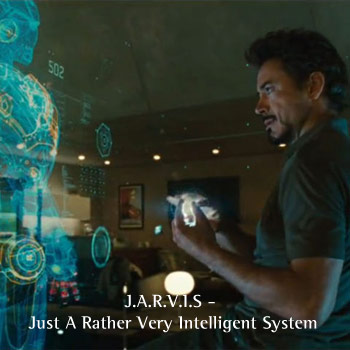
These are just the four major sections where Augmented Reality can help. The complete is really huge to be included here. And, AR is growing to the other areas too.
Virtual Reality – It’s a New World
To start with, we have the definition of Virtual Reality
“Virtual Reality is the computer-generated simulation of a three-dimensional image or environment that can be interacted with in a seemingly real or physical way by a person using special electronic equipment, such as a helmet with a screen inside or gloves fitted with sensors.”
Basically, Virtual Reality makes you leave the real world here. Instead, it transports you to another computer-generated world with graphics and other elements. To bring in the ‘real’ feel, VR includes different elements such as imagery, sound and other sensations. But, in most VR HMDs, prominence is given for Sound and Visual. At the least, you would feel that you are in someplace else.

Using VR, you can do a lot of things. You can be visiting a mountain valley, though you are sitting on the couch. You can feel the air and the visual beauty. Thanks to the various sensors placed in your phone or VR Headset, the visual experience will change as per your changes. You turn to right and you can see the right portion of the mountain. There is something to be noted in the Virtual Reality Vs Augmented Reality game. VR was able to bring much momentum to the industry in a shorter time, when compared to that of AR.
Also, there are differences in terms of hardware.
The Hardware and Projects
HMDs used for Virtual Reality are always full-covering. It’s only then you can have the entire experience of getting moved! However, there are two types of Virtual Reality Headsets you can purchase.
The first type needs your smartphone for the VR Experience. You can insert your smartphone into the slot and wrap that headset around. Accelerometer and other sensors of your smartphone are used for the VR interaction. Several headsets are available in this category, such as Google Cardboard and Samsung Gear VR. Given that you have a VR-compliant device; this is an affordable choice.
Secondly, there are standalone Virtual Reality headsets like Oculus Rift and HTC Vive. These are fully-fledged systems that can provide you all-the-round Virtual Reality experience. You may have to connect these devices to your computer to get the experience. These devices are mainly used for immersive gaming and related experience, especially if we take the case of Oculus Rift. As you can guess, these are much expensive.
And, here too, we have some tight competition in the field of Virtual Reality. We are covering the standalone headsets.
- Oculus Rift: Oculus Rift has been in the news for long. This VR Headset comes with cunning features, such as the OLED Display, a pair of headphones for 3D Audio and Positional tracking. Immersive Gaming is one of the awesome things offered by Oculus Rift. You can be in the game, with the immersive visual and sound effects. It was released in March 2015 and is available at an introductory price of $599. With accessories and games available at the earliest, Oculus Rift is surely the disrupter.
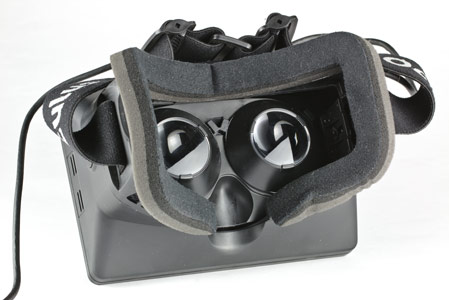
- HTC Vive: HTC Vive isn’t available in the full form yet, but it’s yet another immersive VR Headset. It comes with more sensors when compared to Oculus Rift or other competitors. Of course, given the specifications, you can expect a higher price tag. It has to be noted that HTC Vive is a bit bigger than the other headsets, but the experience should be worth the weight and wait.
- Razer OSVR: The other ones in competition include Open Source Virtual Reality kit from Razer. It’s more of a platform for VR devices, for different devices and purposes. You can connect these devices with the OSVR Kit and enjoy the Virtual Reality — like never before. The capabilities are impressive, but we cannot say other aspects like pricing for sure.
Notable Applications of Virtual Reality
Indeed, there’s a huge number.
- Gaming is what we saw with Oculus Rift. You are not a third-party viewer anymore. You are into the game, by all means.
- Design has gone to the superb levels. For instance, we can take the case of infrastructure design. Isn’t that great if you can go to your individual rooms before you build your house?
- Education sector has a lot to do with the right Virtual Reality technologies. Let it be some constellations or great wall of China; everything can be shown with the help of a VR Headset.
- Films: When we talk about films and video content, we have to talk about 360-Degree Content. You are brought into the world instead of being a spectator.
You know, the list does not end. If you want more, there are VR Porn, VR Sports, CAD and a lot more. When everything is going virtual, we have a VR part for everything.
Virtual Reality vs Augmented Reality – Let’s Sum Up
We have discussed the different aspects of both AR and VR in this comparison of Augmented Reality Vs Virtual Reality. It’s clear that Augmented and Virtual Reality have slighter yet important differences.
Augmented Reality is modifying the existing reality with an additional digital layer. Through this layer, you can find variety of information, ranging from charts to movies and interactive characters. This can widely be used for education and game-based purposes. However, Virtual Reality creates an entirely different form of reality in front of the eyes. Using techniques like imagery and sound, you are transported into the secondary reality. But, as the fact goes on, you feel real when you’re in that created world.
We had covered the similarities in the introduction and we think both are clear. So, depending on what you want — make changes to the current one or create a new reality —, you can pick one from the AR vs VR duo. Make sure that you have the right hardware with you, and be ready to rock!





More Stories
11+ Best ThePiratebay3 Sites – Ultimate Pirate bay Alternatives
7movierulz iBomma – 11 Best Alternatives to Download & Watch latest Telugu Movies
How to Spam a Phone Number (7 best apps & services) with call, texts to Get Revenge?